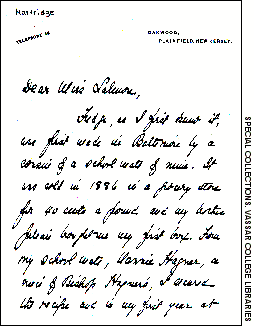Fudge
I happen to have been hunting down the early history of the name for this sweet recently for a different purpose and was intrigued to find that it’s a relatively modern confection, at least under that name. The Oxford English Dictionary has its first example from as late as 1896, in which the writer describes fudge as “a kind of chocolate bonbons”.
These days, with electronic archives that allow one to solve in moments a problem that a researcher of a previous generation might have taken weeks over, it took me about half of no time at all to find an earlier example, from the Davenport Daily Tribune of Iowa for 22 February 1895:
“Nearly every night at college,” said the Vassar girl, “some girl may be found somewhere who is making ‘fudges’ or giving a fudge party.” Fudges are Vassar chocolates, and they are simply the most delicious edibles ever manufactured by a set of sweetmeat-loving girls. Their origin is wrapped in mystery. We only know that their receipt is handed down from year to year by old students to new, and that they belong peculiarly to Vassar.
This was an interesting find, my exhilaration at having unearthed the Vassar connection being only slightly dampened when I found that many had made the same discovery previously. Chief among them was the US researcher Barry Popik, who five years ago went to this famous — originally women-only — college at Poughkeepsie, New York, to read through the Vassar yearbooks of the period. These contain many mentions of fudge, including this ditty from 1893:
What is it that we love the best,
Of all the candies east or west,
Although to make them is a pest?
Fudges.
What perches us upon a chair
To stir a sauce-pan held in air,
Which, tipping, pours upon our hair —
Fudges.
What needs more stirring than oat-mush,
And more still when we’re in a rush,
But what’s e’en sweeter than a “crush”?
Fudges.
What subtle odor doth recall,
To artless minds that “long-owed call,”
On the sweet maiden up the hall?
Fudges.
The puzzling reference in the second verse is explained in the newspaper article: “It never tastes so delicious, however, as when made at college, over a spluttering gas lamp, in the seclusion of your own apartments.” The thought of long-skirted maidens balancing on chairs to heat pans over a gas mantle above their heads would make a modern safety-conscious teacher blench.
The newspaper article and the poem presumably pluralise fudge from its being cut into pieces for serving. When the word gets out into the wider world in this new sense, at around the turn of the century, fudge becomes a collective noun. Despite the use of the word chocolate in the newspaper article and the modern implication in the US that fudge is normally chocolate flavoured, the recipe accompanying the article lists only sugar, butter and milk, the “traditional” fudge known in Britain. The making of fudge to much the same recipe was a craze around this time at several US women’s colleges, including Wellesley College and Smith College.

The poem is the earliest dated reference to the word we have in this sense. However, there is also a letter in the Vassar archives from a former student, Emelyn Hartridge, to her professor, Lucy Salmon, telling how she introduced fudge to the college. According to Lee Edwards Benning in Oh Fudge!: A Celebration of America’s Favorite Candy (1994) this was written long after the event, on 11 December 1921:
Fudge, as I first knew it, was first made in Baltimore by a cousin of a school mate of mine. It was sold in 1886 in a grocery store for 40 cents a pound and my brother Julian bought me my first box. ... I secured the recipe and in my first year at Vassar I made it there — and in 1888 I made 30 pounds for the Senior Auction, its real introduction to the college, I think.
Tantalisingly, she doesn’t mention when it became known as fudge — might its first maker or the owner of that grocery store in Baltimore have given it its name? If either did, a record of the verbal ingenuity of this mute inglorious Milton has not survived.
How it came by the name is still a mystery. Fudge first came into the language in the late seventeenth century as a verb meaning “to fit together in a clumsy or underhand manner”. This could refer to putting facts or figures together in a superficially convincing way or to patching something up to disguise its faults. This led to the cry of fudge!, meaning nonsense, and to senses of the verb such as to talk rubbish or to cheat in exams. Our modern usages, such as “an unsatisfactory or makeshift solution”, “to avoid commitment”, “to dodge the issue”, or “to deal with something in a vague or inadequate way”, come from this.
None of this is any sort of guide to how it became a name for a sugary confection. Some Oxford Dictionaries suggest that an early usage of fudge was in the sense “to turn out as expected” or “to merge together”, which may have led to the confectionery sense. But I can’t find any supporting evidence for the word having being used in this way, nor how it might have survived into the 1880s. A story repeated in several places online says it came from the bungled or “fudged” making of a batch of caramels on 14 February 1886, which is a suspiciously precise date, more so because it was Valentine’s Day — it feels like a folk etymology invented long after the event. It’s seductive, though, because you can almost hear the cook muttering “fudge!” on seeing the results, as a polite alternative to a much ruder word.
